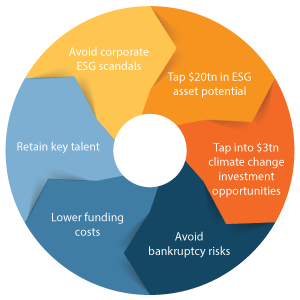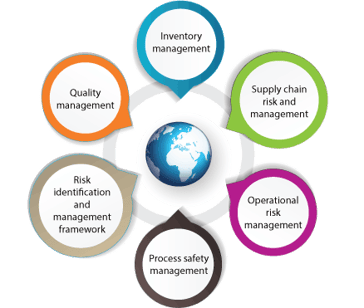How to Improve Market Performance through Intentional Corporate Culture
 In an article he wrote for Forbes, David Michaels likened change to surfing in that “change, like waves, actually never stops. It can be large or small, fast or slow, but it is continuous.” The amplitude, direction, and organization of waves are determined by global forces and local conditions. Surfing is indeed an apt business metaphor and illustrates the importance of corporate sustainability and safety culture in times of changing tides. Global forces and local conditions determine the amplitude, direction, and organization of both, and the peaks, valleys, risk, and reward are exhilarating when it pays off. When it does not, both surfer and businessman are left humbled; reminded that we can only harness, not control, such a powerful force.
In an article he wrote for Forbes, David Michaels likened change to surfing in that “change, like waves, actually never stops. It can be large or small, fast or slow, but it is continuous.” The amplitude, direction, and organization of waves are determined by global forces and local conditions. Surfing is indeed an apt business metaphor and illustrates the importance of corporate sustainability and safety culture in times of changing tides. Global forces and local conditions determine the amplitude, direction, and organization of both, and the peaks, valleys, risk, and reward are exhilarating when it pays off. When it does not, both surfer and businessman are left humbled; reminded that we can only harness, not control, such a powerful force.
We are experiencing an unprecedented global crisis caused by a novel animal-borne corona virus for which we have no defense or answers for. The significance of this disruption will not truly be understood for years, but already, it has transformed the high streets, laying low the old guard alongside independent retailers. Market analysts observing from the shoreline are wondering what secret enables untested brands to ride the rogue wave sets that have taken out their stalwart competitors. This disruptive force has shifted the global conversation from growth and viability to survivability and whether businesses will have the financial and human resources to weather this uncertainty. As events unfold, the case for sustainable management practices is adding to its catalog of supporting evidence.
Surfing holds wisdom and insights on navigating uncertainty for those piloting businesses through the white water wrought by Covid-19. To borrow from Heraclitus, no surfer paddles out into the same ocean twice because it is not the same one. A surfer requires both stability and flexibility in equal measure to successfully catch and ride a wave to shore. The strategies employed by surfers are inextricably linked to and influenced by both the legendary surfers they idolize and the values and behaviors their heroes imbued into the fabric of the culture they set into motion. Likewise, business leadership defines the corporate culture that unifies and mobilizes the people who will carry out their employer’s corporate vision.
How Does Safety Culture Impact Market Performance?
“Waves are not measured in feet and inches; they are measured in increments to fear.” ~ Buzzy Trent
Like the ocean, the global financial market is constantly changing and the ones who play in its waters ignore global conditions and current events at their own peril. The size and historic success of an organization cannot be used to determine their future success or profitability, as we have seen daily over the past few months. For economists interested in sustainable business development and market performance, analyzing the impact of coronavirus on the markets has provided strong and conclusive evidence linking sustainability to overall, long-term corporate viability.
According to a new report conducted by Bank of America (BofA) Global Research strategists, since the market peak on February 19th, stocks with better environmental, social, and governance (ESG) scores have outperformed those with lower ESG profiles by five to 10% in US and European markets. Additionally, over two-thirds of actively managed equity funds beat their benchmarks and flows of ESG exchange traded funds stayed positive. BofA summarized their findings by stating, “ESG is a bear market necessity, not a bull market luxury.”
Bank of America is not alone in researching the links between sustainable management practices and market performance. The American College of Occupational and Environmental Medicine (ACOEM) studied the market performance of organizations that applied for or received their Corporate Health Achievement Award (CHAA). They found that when leadership “engaged in measurable efforts to reduce health and safety risks among employees” over a 13 year period, CHAA companies achieved as much as triple the average return rate—between 204-333% returns compared to an S&P return of 105% during the same time period. The authors of that study proposed that a standardized Integrated Health and Safety Index (IHS Index) modelled on the Dow Jones Sustainability Index (DJSI) would be beneficial to investors assessing the risk potential and value of companies. Bank of America reached a similar conclusion, “ESG is the best measure we’ve found for signaling future earnings risk, and is superior to leverage or other risk and quality factors.”
Among other market performance benefits, strong organizational health and safety culture will help you:

* Avoid corporate ESG scandals
* Tap $20tn in ESG asset potential
* Tap into $3tn climate change investment opportunities
* Avoid bankruptcy risks
* Lower funding costs
* Retain key talent
What Makes an Organizational Culture of Sustainability Strong and Successful?
All it takes is one person who is committed, focused, and on a mission to spark an entire team into believing in themselves." ~ Bruce Brown
As an entity, a business is shaped by the collective experience, values, and vision—the culture—of the people who maintain it. It is the thread of inclusivity—of shared identity—that connects individuals to the collective; when successful it inspires cooperative participation that allows the organization to maintain that delicate balance between flexibility and stability necessary to navigate the rip currents and ride the wave safely to shore.
Leaders who take an active interest in their employee’s wellness and act on the advice of safety experts like their EHS managers will imprint associated behaviors and values onto the culture. In turn, these corporate environmental, social, and governance policy improvements will incur employee loyalty, higher investor approval, and overall improvements in their market performance.
Like surfing, a corporation’s capacity to thrive in uncertain times will depend on the level of trust employees place in leadership, and their ability to unite employees to a shared sense of purpose All businesses devote time and resources to protecting their financial health and limiting their risk exposure. They consult experts who help them to develop strategies to help them achieve goals to those ends. Fewer resources and experts are purposed for addressing the health and safety of the employees responsible for executing the tactics intended to achieve those goals.
EHS managers and certified safety professionals are underutilized resources in corporate strategy planning and involving them early in the planning process will allow you to address your company’s distinct environmental strategy concerns. Because they develop workplace safety goals and the policies that will satisfy them, EHS managers are uniquely qualified to advise leadership committed to instituting a successful safety culture by improving their ESG index.
Safety professionals are ideally situated within an organization to ensure accurate scenario planning in strategic management planning because they must be on-site in order to ensure that health and safety guidelines are both appropriate and being followed throughout the facility. They can ensure that your business sustainability strategies and practical, enforceable, and well-received by the people who must ultimately carry them out.
The data they collect for EPA and OSHA compliance touches on every aspect of operations and is invaluable to strategic management planning. Your EHS manager will frame this data within the context of your organization and provide insight on your organization’s:

* Inventory management
* Supply chain risk and management
* Operational risk management
* Process safety management
* Risk identification and management framework
* Quality management
In addition to the tangible benefits like operational improvement, ESG practices implemented with guidance from safety professionals foster a sense of unity and lays the foundation for a strong corporate culture of sustainability which reinforces and improves sustainable operations throughout the business.
Can EHS Managers Use Green Technology to Improve our ESG Index?
 EHS managers must split their time between compliance reporting and overseeing facility safety. EPA compliance reporting require a significant time investment for EHS managers and may explain why safety managers are underutilized in business development strategy planning. Careful EPA compliance prevents environmental auditing and the accruing of steep non-compliance fines. Corporate leadership often views compliance reporting as the primary function of the safety professionals they employ because EHS personnel are often required to author several compliance reports every year. Each report undergoes several changes annually both federally and at a state level, and their accuracy depends on the quality and organization of the data collected. EHS managers must devote weeks if not months to their completion in the lead-up to deadlines, as well as several hours weekly throughout the year to appropriate data collection and archiving.
EHS managers must split their time between compliance reporting and overseeing facility safety. EPA compliance reporting require a significant time investment for EHS managers and may explain why safety managers are underutilized in business development strategy planning. Careful EPA compliance prevents environmental auditing and the accruing of steep non-compliance fines. Corporate leadership often views compliance reporting as the primary function of the safety professionals they employ because EHS personnel are often required to author several compliance reports every year. Each report undergoes several changes annually both federally and at a state level, and their accuracy depends on the quality and organization of the data collected. EHS managers must devote weeks if not months to their completion in the lead-up to deadlines, as well as several hours weekly throughout the year to appropriate data collection and archiving.
The risk events that impact site safety and employee morale are more likely to occur when safety management are absent from their duties supervising the safety of your employees and facilities. Their presence also assures front-line employees that corporate leadership is invested in and takes seriously the health and safety of their staff. For these and so many other reasons, EHS and safety managers are instrumental in maintaining the culture of sustainability that ensures successful implementation of of corporate ESG policies.
Automated EHS compliance software is a practical green technology that will improve your ESG index and allow strategists and management planners to monitor their operations in real time. EHS automation software allows you to leverage your EHS manager’s insights, minimize risk exposure, improve employee morale, and foster your corporate culture of sustainability.
Regardless of which waters you paddle out into, the tools and strategies that were once successful may not be suitable in what will be the new normal. Now, more than ever, corporate sustainability strategies that address their environmental, social, and governance impacts can help prepare businesses for the new normal and its numerous unknowns. Sustainability is, ultimately, about remaining viable in the long-term.
ERA has previously written a case for sustainability as a business strategy which touched on the importance of corporate sustainability culture in achieving sustainable management goals. The mainstream markets have born out the link between a company’s ESG performance and its capital costs, profitability, and share price stability.
Discover how ERA can help your EHS team to improve your ESG index
This blog was co-authored by:


Tags:
SustainabilityMay 13, 2020

Comments